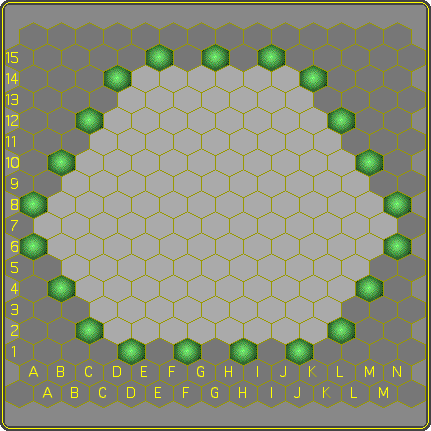However immature, the game turned out fine, eventually, because of suggestions made by David J Bush, a world class Twixt player, so he shares YvY's copyright with MindSports.
I'm very pleased with another strategy game, but at the same time I think it's time to call it a day. I missed YvY in the first approach, and even after David's suggestions, hunting it down to it's essence was rather tedious. I was surprised in fact when it suddenly came together in a very simple way.
 | YvY is played on a special board. Mindsports features a 'base-7' one, with 7 sprouts - the green cells - along any two adjacent sides.
|
Groups & Loops
- A 'group' consists of a number of connected like colored stones. A single stone is a group by definition.
As in Go, calling a number of stones a 'group' is most of the time meant in a less formal way. - A 'loop' is a group that completely surrounds one or more cells. Whether or not such cells are occupied, or by whom, is irrelevant.
Object
- The game ends in one of two ways:
- By sudden death: if a player completes a loop he wins, regardless of the score.
- After both players pass on successive turns: now the player with the highest score wins.
Life & Death
- A group lives if at least one of its stones occupies a sprout, otherwise it is (as yet) dead.
Territory & Scores
- If a game ends by the players passing on successive turns then dead groups are removed from the board before the counting starts.
- After the removal of dead groups, any group fenced in by a group of like color, is considered part of that same group.
- The score of each player is the number of sprouts he controls (that is: sprouts occupied or fenced in by his stones) minus twice the number of his groups.
If, for example, one player has followed a center oriented strategy, resulting in one group controlling 11 sprouts, his score would be 9. The other player controls the remaining 16 sprouts, so if he managed to do that with three groups, he has 10 points and wins, but if he needed four he has 8 points and loses. This is a game of 'divide and rule'!
Note: if one player's score is even, the other's will be odd, so the game cannot end in a draw.
Strategy & Tactics
In terms of tactics, YvY first and foremost requires reading the hexplane the same way as in games like for instance Hex and Y, but the presence of the loop as an absolute criterion to win makes its tactics much more Havannah like. In fact YvY might be considered a 'generalized Havannah' in which the concept of corners and sides has been replaced by by an odd number of evenly distributed sprouts and the goal is, roughly speaking, to connect as many of them as possible with as few groups as possible.
Not surprisingly, the strategic dilemma of Havannah - 'spider' versus 'snake' - is revisited here. The edge is important to get control of a sufficient number of sprouts, but the center is clearly the area where connections are made. One may sacrifice a couple of sprouts to connect one's own live groups, as in the example given in the rules: one group controlling eleven sprouts wins if the opponent has four groups or more, and loses if he has three groups or less. The resulting tension between moving near the edge or higher up is totally reminiscent of Havannah, as is the loop, that fulfills the same tactical role: a tool to cut and/or connect.
There are important differences nonetheless. In Havannah the fastest connection is usually very important, whether it be ring, bridge or fork. A frame doesn't mean much if the opponent has a faster one. In YvY the score is accumulative, and in terms of the absolute win, a loopframe will usually not face a faster threat (the only option being a faster loop). So basically framing is winning.
Another difference is that YvY will usually have a 'Go type' opening, with claims staked out along the edges, whereas Havannah can have many different types of opening. YvY definitely feels more Go like than Havannah.
Example game
Here is a base-9 YvY game, played between Christian Freeling, white, and Ed van Zon. Both are seasoned Havannah players.
Christian Freeling - Ed van Zon (0-1)
a word on notation
YvY © MindSports and David J Bush
Java applet by Ed van Zon
